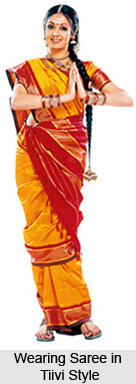 The dimension of sarees varies from state to state as a wide variety is found in length, width and quality. A good quality saree made of expensive fabric, like dense silk or fine cotton muslin, will often be both broader and longer than one that is less costly. The local people of a state mainly people of the peasants class and urban poor wear less expensive mill-made sarees that are noticeably short in length and width.
The dimension of sarees varies from state to state as a wide variety is found in length, width and quality. A good quality saree made of expensive fabric, like dense silk or fine cotton muslin, will often be both broader and longer than one that is less costly. The local people of a state mainly people of the peasants class and urban poor wear less expensive mill-made sarees that are noticeably short in length and width.
Apart from these, the dimension of the sarees is different in case of traditional sarees. Many traditional heavy cotton sarees worn by tribal, peasant and low-caste working women have always been short in order to facilitate movement. Traditional saree dimensions are also influenced by regional and community draping styles. In the Dravidian south, many poorer low-caste and tribal women as well as some conservative orthodox Brahmins wear sarees that are 7 to 9 metres (23 to 30 feet) long. These sarees are draped in various trouser-like forms by the women, which are traditional to their communities. Such draping styles, and sarees`, are rarely worn by today`s urban middle classes as they have adopted the now ubiquitous tiivi style. This tiivi style, during the last century was only worn in the western Deccan and some areas of Dravidian India.
The dimensions of the sarees differ from state to state depending on the tradition and the culture of the place.
This article is a stub. You can enrich by adding more information to it. Send your Write Up to content@indianetzone.com





















